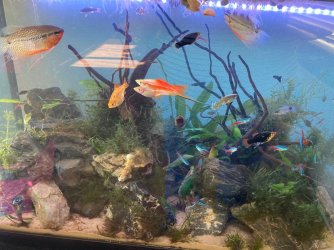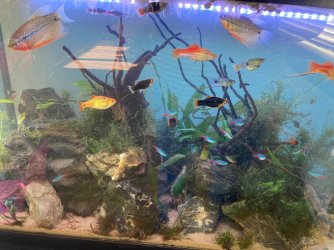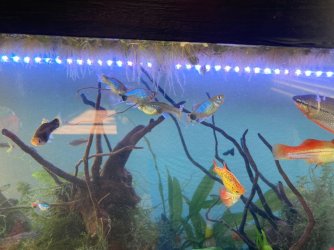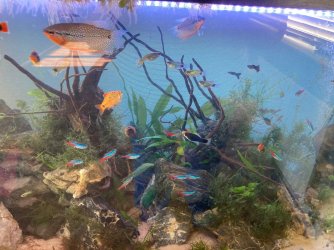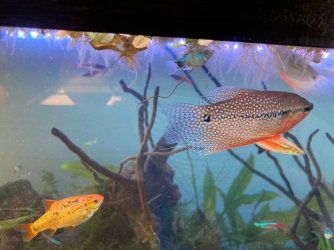Trigger Warning - long rambling essay post. It annoys some, but it's just how my brain works! Anyone is free to skip reading it.
 @rebe
@rebe Hi! I don't think I've seen you before since I've been AWOL on the main forum threads for a year or so, but love that you're helping
@Flowerfairy13 in person and giving them plant trimmings!
@Flowerfairy13 said you recommended this forum (yay!) and that you're knowledgeable, do you agree with what I'm thinking about heavily stocked tank and a bit of old tank syndrome going on, and potentially some disease or parasite like worms being introduced and causing long term stress, and eventually, deaths?
Sorry to be nosey, but because I haven't been active on the forum recently, I don't know many of the newer posters well, but would like to make up for it and help where I can, if I can! But I'm not an expert on anything, just another hobbyist who has spent a lot of time here, and had to go through similar things when I inherited an overstocked and neglected tank with livebearers, then began keeping livebearers myself, that turned out to have worms, so I had to do a lot of research, get advice here, and a lot of work to make sure my tanks are free of disease! But the more people that chip in with their opinions and advice, the better!
So the nosey part - I had a quick scan of the threads you've made
@rebe , and wondered whether the tank in this thread belonging to the friend you were trying to help was
@Flowerfairy13 's tank?
I am trying to help a friend out with their aquarium. They have had a difficult experience with fish keeping so far, and they need help with their zebra danios. I have never kept danios so I can only offer what I am able to research online. I'm really hoping that those of you with experience...
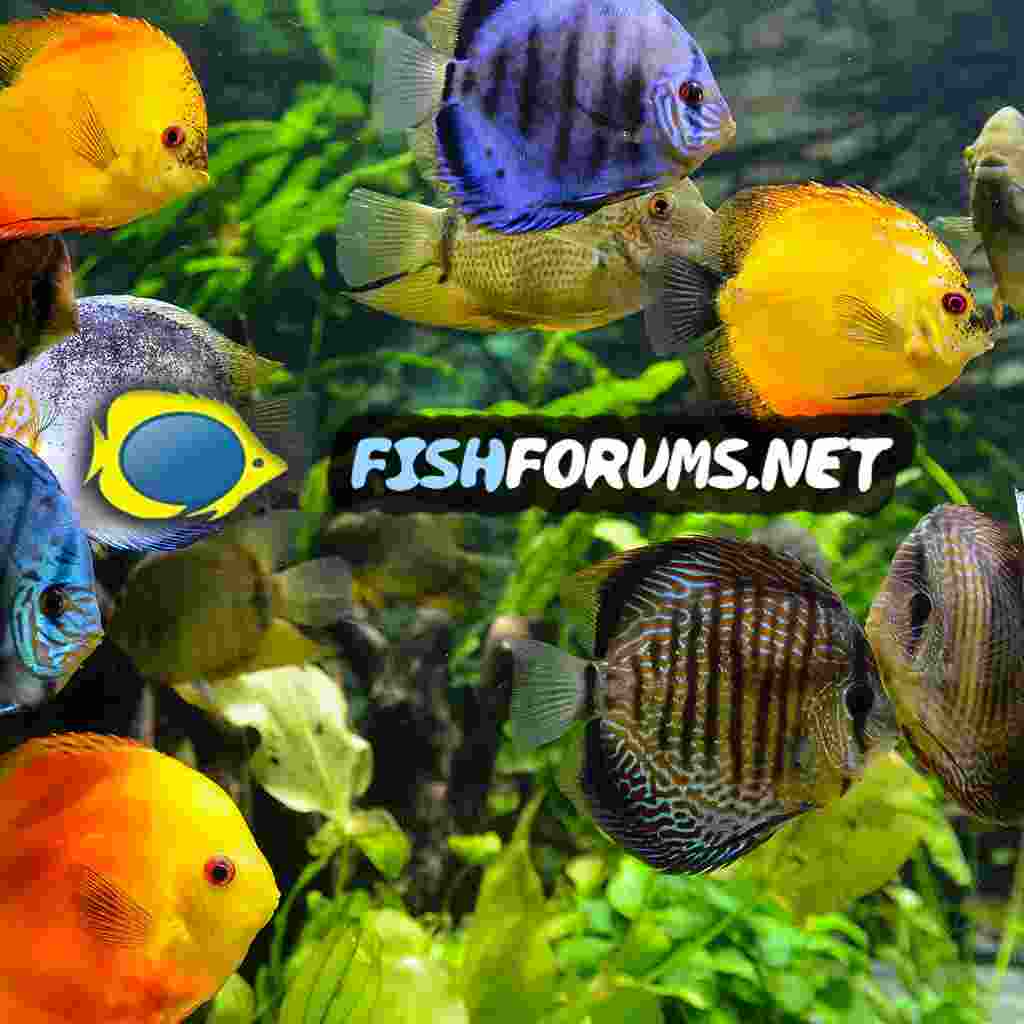
www.fishforums.net
Just because taken all together, getting that tank history can be helpful in attempting to diagnose.
Sounds like you might be overfeeding a bit, sorry to say! We all tend to do that, since it's fun to feed the fish, but more food in means more uneaten food waste rising nitrite levels (and exploding populations of pest snails! Do you get over run with bladder snails at times?) plus more food in the fish means more waste expelled.. plecos are known for being waste producing machines... a bristlenose is fine in a 66g tank, but since it's also an established tank with lots of natural food in there, fed twice daily, adding a whole algae wafer daily for the bristlenose may also be too much, and contributing to the high nitrate levels.
Do you see the bristlenose eat the whole wafer? I snap an algae wafer in half, one half each side (they have their own sides of the tank for their fav hiding spots) for two L181 plecos in a 57g only a couple of times a week, since they also eat biofilm and algae from the tank, and the bug bites and live and frozen food I add for the upper level fish and corydoras.
I do like that you have a big gang of cories!

In decent numbers for each species. Love to see it! And much like my set up, only I have two L181 plecos, around 10 bronzes and 2 albino versions of bronzes, 6 sterbai cories, and some spotty rescue cories I adopted and added to the gang, since at least they have the company of the other cories and better water conditions than they had before.
Can you give me the tank dimensions, please? Length, width and height. Just want to check with a stocking calculator how it's looking stocking wise, with or without neons.

Just beware that it's the growing livebearer fry which will keep being produced and can rapidly get out of hand that is pushing your tank stocking, plus a lot of bottom dwellers too. It's nice to have a large gang cories, but when you have a lot of bottom dwellers (including messy plecos), top level fish like gourami but without floating plant cover that they like (I know you're getting some from
@rebe though, which all the fish will appreciate!), and then a ton of breeding midwater dwelling species like tetra and all the livebearers that can reach large sizes given the right conditions, while popping out huge batches of fry, often... I definitely wouldn't add any more stocking, and would check with your local fish stores if they're willing to take young livebearers you've bred yourself, because not all will I'm afraid.
Is it the API Freshwater master test kit?
If so when testing nitrates, and the instructions tell you to shake the bottle and tube for a minute and for 30 seconds? It doesn't emphasis it enough.
@Essjay taught most of us this, and in one old thread I made because I found my test tubes were becoming stained a light blue, no matter how I tried to clean them, and the chemicals used in the second (is that right, essjay?) bottle for nitrates separate easily, need to be really knocked about, banged against the wall, shaken hard for ages - heck, throw the bottle across the room a few times even! It separates easily, and really needs to be banged about and shaken hard to make it mix again before each test, or it can give false results.
My test tubes were becoming stained because I would often test, put the full tubes back in the kit in the cupboard while I mucked about with the tank and filter etc, because I didn't want to clumsily break the tubes, then forget to clean out the tubes until I next tested a week later.

So the nitrate solution was leaving residue on my test tubes that wouldn't just easily wash off and could skew the results for all future tests.
It's also better if you can take a water sample to test from lower down in the tank, not from the surface. Use something like a clean syringe or turkey baster (unused, just for fish keeping purposes! Surprisingly useful bit of kit) to take some water from lower down in the tank, not from the surface.
I can't remember why that's important, I'm a chemistry dunce, but remember
@Essjay and
@Wills all discussing this when we were talking about my laziness about not washing out test tubes immediately stained my test tubes, not shaking the bottle enough for the solution to mix properly, or taking the sample from the surface, can skew your results.
So much to learn and share in this hobby! But that's what this forum is all about.

As
@emeraldking said, these fish store livebearers tend not to be healthy stock, especially when buying from large chain stores. They're mass produced in huge fish farms abroad then shipped around the world. Disease like worms, ich, gill flukes etc spread like wildfire under these conditions and in even the best stores, if one tank of fish has worms and a net is used in the worm infested tank then used in another tank, worm eggs can be transferred that easily.
Fish also often jump from warehouse tub to another warehouse tub, or in stores from tank to tank too. It's not rare to find a male guppy has jumped into the female guppy tank next to them and had a wild time... then not only can disease spread that way, but the people buying female livebearers often find fry appearing even with no male around, since female livebearers can store sperm packets and choose when to use them, continuing to pop out fry for months, even up to a year, even if no males around, just from that one contact from the leaping fish store male!
So even if you reach the point of wanting to stop them breeding, it's not as easy as separating the males and females, since the females will have stored sperm packets, and with each female producing maybe 30 fry a month on average, which then need separating out into different male and female tanks as soon as the fry are old enough to sex, or the young females will soon also be gravid by about three months old.
Guppies are called "the million fish" in some places for a reason! They're so pretty though, and breeding them can be a lot of fun. So long as a store is willing to take batches of juveniles from you once old enough to sell, so you don't wind up overstocked. Or if you don't mind doing private sales through somewhere like gumtree.
Anyway, because fish store guppies tend not to be the healthiest stock, they're not the hardy fish they were 30-40 years ago. If you can get some fry from them, the fry are usually healthier and longer lived. But if you bought a juvenile/adult guppy from a chain store, a year and a half is pretty good, for a fish store mutt guppy. Sorry you lost your favourite though, been there.


The bloating can be a result of overfeeding, or the worm load the fish is carrying becomes overwhelming and kills the fish. Dropsy is a symptom rather than a disease of it's own - it's a symptom of the organs failing, which is why it's nearly always fatal. Hard to reverse organ failure once it's started in any animal, including humans, so very hard to stop if a fish has reached that point.
Can you describe any other symptoms the fish showed before passing away, or how you found them? Any listlessness, skinniness, long stringy white poop?
Highly doubt the brine shrimp did any harm, and I'm sure the fish went wild for the live food! It's fun to watch the hunting behaviour when you feed live food. It's different from how they react to commercial dried foods, or even frozen foods. Love to watch gourami hunt for live food among the floating plants!
Can you get more photos or even better - videos - of the fish? Seeing their movement can help a lot. Videos won't upload directly to the forum, but if you upload them to youtube, can link it here.
Remember that the fish you buy in store are nearly always juveniles. Behaviours can change a lot once fish mature and reach breeding age and condition. Gourami are very territorial surface feeders, labyrinth fish, and males build bubble nests on the surface when ready to breed. They appreciate a lot of plant cover to hide in for these reasons. It's also why I recommend stopping adding stress coat. It's not that helpful, and research has shown it can be harmful to labyrinth fish like bettas and gourami, since it contains aloe vera that can coat the labyrinth organ. The Prime and Flourish are good products though.

I don't know enough about gourami to sex them, but someone else here will be able to for sure.
If you got them a while ago, the change in behaviour is likely down to them being juveniles when you got them, they've matured to adulthood in your tank. Then not having enough plant matter to break lines of sight and establish territories, and getting the balance right can be tricky, including male/female ratios and number of gourami in the tank of which sex, and some gourami species being more aggressive than others. Your pearls are usually known as being more peaceful I think, but if you have say two males who each consider the whole tank their territory, they could fight over that. With clear pictures of them both, or video, I know someone else will be able to sex them, see if they're getting into breeding condition, and give more specific gourami advice!
I'm sure yours will be thrilled by the floating plants and fast growing stem plants (leave some floating, don't plant all the hornwort/elodea, leave some to float and it'll still grow well, can reach CO2 at the surface, give fry a hiding area, and the gourami will appreciate it too. Hopefully with that cover so the two gourami aren't in each others eyeline all the time, they might each establish their own parts of the tank and settle down.
If stuff like that happens in future, net out what you can, then use the gravel/sand vac to remove as much of the food from the tank as possible, and do a large water change. One gorging session might make the fish fat and bloated for a bit, but shouldn't cause long term damage. The problem is more the excess food in the tank rotting and producing more ammonia than the tank can handle, along with the fat well fed fish producing even more waste than usual - can cause an ammonia and nitrites spike, then high nitrates as the bacteria slowly processes it.
Removing as much from the tank manually as you can means the excess won't be sitting in the tank rotting and still being gobbled up by the fish, and the large water change to try to get the water as clean and fresh as possible, with as low nitrates as possible, since you know the bioload of all that extra food the fish ate will produce more waste than the tank usually has to process, and with a heavy stocked tank, that can lead to disaster quickly without intervention.
A friend of mine turned her back on her tiny kid for a minute while cleaning her tank, and the kid dumped a whole tub of flakes into the usually pristine and heavily planted tank, made such a mess! But was also an emergency -she had to do back to back large water changes to suck up as much of the flakes as possible, then daily large water changes and using Prime to bind ammonia and nitrites and keep the fish safe between those huge daily water changes as the tank stabilised again.
Had she left it in there, ammonia would have spiked so high it would have killed off the whole tank of fish by the morning.
Not always, especially not with worms. Worms reproduce by laying eggs that fall from the adult fish's intestines, and are eaten by the other fish. Once the fry eat some worm eggs, it continues eating and growing as usual. Worm eggs hatch in the fry's intestines, and latch onto the insides of the intestines to steal nutrients from the fish. They're a parasite, but at first, they're still quite small and not taking too much from the fish.
In the wild, the fish aren't usually overfed, so neither are the worms, so both fish and parasites will grow and reproduce more slowly.
In our well fed tanks, fry will continue to grow, as will the worms. Depending on how many eggs the fish has eaten, if it's infected with both flat and roundworms, and has a heavier burden of worms than others, it will begin to suffer and fail as the worms take more and more of the fishes nutrition, damage the fishes intestines by latching on and causing internal damage, and the fish begins to waste and become listless. Then those growing, well fed worms produce more and more worm eggs, which fall to the substrate, and can be transferred easily between tanks via shared equipment like nets and buckets, or moving fish or plants between tanks.
In one of the photos, a dalmation molly and a couple of guppies had that "wormy look" to them that I recognise, I think, although a video would be clearer.
A large, otherwise healthy, worm-free fish introduced to a tank with worms might pick up a couple of worm eggs that hatch, but the worm load remains small and not too draining on the fish for months, maybe even a year if not heavily overfed or also stressed by high nitrates... until it does becomes too much.
Even when treating for worms, sometimes the worms die inside the fish but aren't expelled, then the dead worms rotting inside the fish's body kills it. Or if it had a heavy worm burden and did expel the worms, the wounds from the worms latching on being left open and exposed can still be too much for the fish, or develop a secondary infection.
So the tiny fry aren't the first affected. Once my camallanus worm outbreak happened, I was losing fish of all ages except newborn fry, but began to lose a lot of young once they'd reached 2-3 months old, and they had eaten a lot of worm eggs, and the worm burden was now too much for them.
The worm eggs are why it's important to use the substrate vac as often as you can before, during and after treatment, every water change, gravel vac as much as you can, and complete the treatments. Anyone with multiple tanks and suspected worms should treat all of the tanks at the same time. Trust me on that one! You'll regret it if you try to just treat the one tank you think is infected but skip the others since it's expensive to treat multiple and large tanks... but it's worse to discover worms are still present in another tank six months later and have to do it all over again!
Not a coincidence, you did the right thing asking for help, losing so many so close together does mean something is wrong, and I still suspect old tank syndrome from heavy stocking/overfeeding/not enough large water changes, live plants and filtration to handle the bioload so long term high nitrates cause stress and damage over the long term, until it reaches a tipping point. You caught it at a tipping point and did what you needed to resolve it.

But I also still strongly suspect worms, and they've reached a tipping point there.
@emeraldking is a livebearer breeder, expert and author, so definitely trust his advice above!
Whoops, see above for the answer to that!
High nitrates also won't kill fish and fry instantly when they're born into it, or it rises gradually. It's a long term stressor, and might slow growth, but born into it and with no choice, they will do their best to survive and grow. Plus the worm thing explained above.


That's brilliant, kudos for getting straight on it! Roughly what percentage of the tank water did you change?
Can you test your well water for all the parameters you can, and share the numbers here please?
Then the test results for the tank either tonight, or tomorrow, bearing in mind the above advice about the API nitrate test kit and sampling.
It's awesome to have hobbyist friends on the forum, and even better local to you! Getting involved in local fish clubs and events, trading things via things like the BAND ap and Gumtree, or FB, so you find local hobbyists can help you rehome youngsters, sell fish or unwanted equipment, find cheap tanks second hand (you could pick up a cheap second hand basic ten gallon for a QT/hospital tank, no need to save up for a new one or spend a lot of money! Just give it a good clean before use.
I'm happy to help when I can!

Especially when the keeper is willing to put in the work to help the fish, plus I remember what a nightmare it was when I dealt with similar issues, so if we can help you through that and avoid a tank crash and you losing more fish, then we're happy!
No need to go expensive, or have another tank permanently set up for QT when you have an established tank to borrow from - but only after you've treated the main tank for worms. A second hand smaller tank is fine for the species you have for a month of QT, observation, and potentially medication for worms before adding new stock (especially with livebearers). It's safer and cheaper to worm them in a little 10-15g tank prior to adding them to your main tank(s), and know for sure they're not re-introducing worms into your (hopefully worm free after treatment) large main tank again!
Awesome to fast them for a few days. Would also be interesting after you've run the ammonia/nitrites/nitrates/pH etc tests on the tank after fasting for a while, if you then feed the previous amounts you used to do twice daily plus the algae wafer for a few days, then test the water again and see what the results are.
The fast growing live and floating plants will help reduce nitrates simply because they suck up and use the ammonia faster than the nitrifying bacteria can, so less of the waste is processed by filter bacteria into nitrites and then nitrates. Some filterless tanks rely entirely on plants. But can't really do that without heavy planting of fast growing plants, and a lightly stocked tank without a high bioload.
Heavily stocked and breeding tanks, even with live plants, will need larger and more frequent water changes, and things can go wrong faster since the tank is so full and with a heavy bioload, so can turn toxic quickly.
You don't need charcoal in the filter all the time. It does get "full" after a month or so, so when using it to remove meds or something, needs replacing or recharging monthly to be effective, so it's pointless and expensive to use charcoal all the time. Replace that gap in the filter with sponge or filter foam cut to size, then only use the charcoal when you've finished a course of meds, and the charcoal can help remove the traces left behind after your water changes. Or if the tank is otherwise good with stable water conditions and parameters, and you just want that polishing from the charcoal.

Whew! Sorry for another super long reply and info dump! It took ages and I just did it a bit at a time between chores and cleaning.



 www.fishforums.net
www.fishforums.net




 So the nitrate solution was leaving residue on my test tubes that wouldn't just easily wash off and could skew the results for all future tests.
So the nitrate solution was leaving residue on my test tubes that wouldn't just easily wash off and could skew the results for all future tests.

